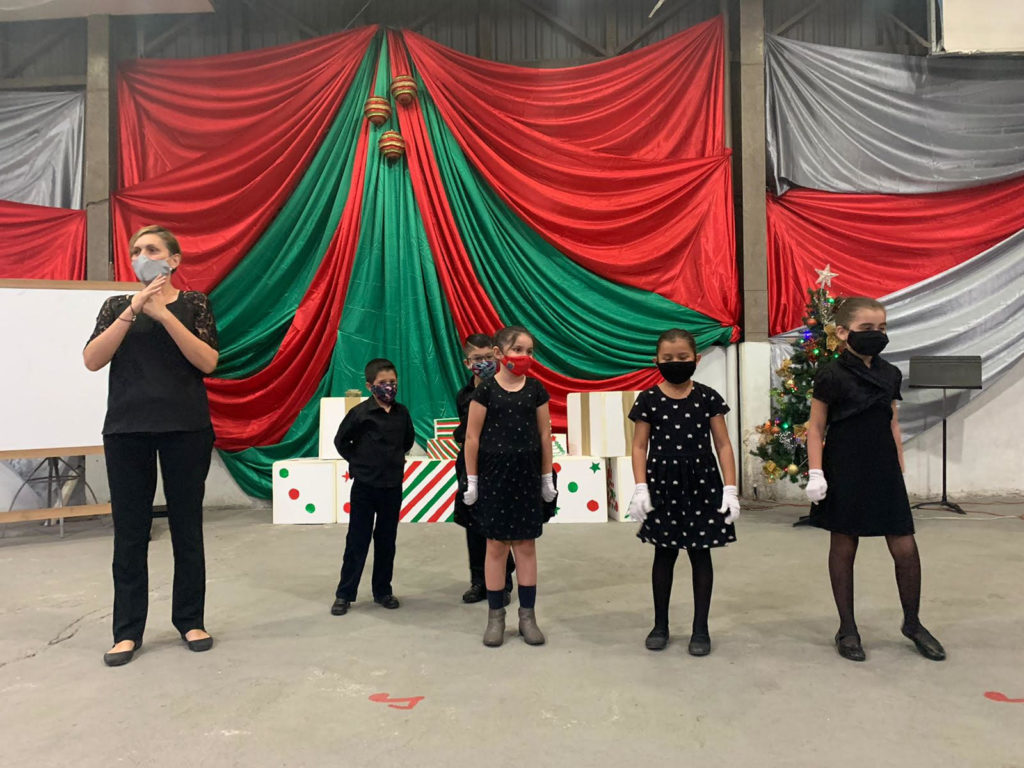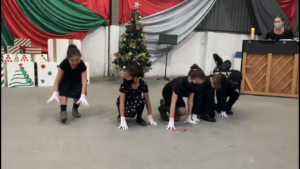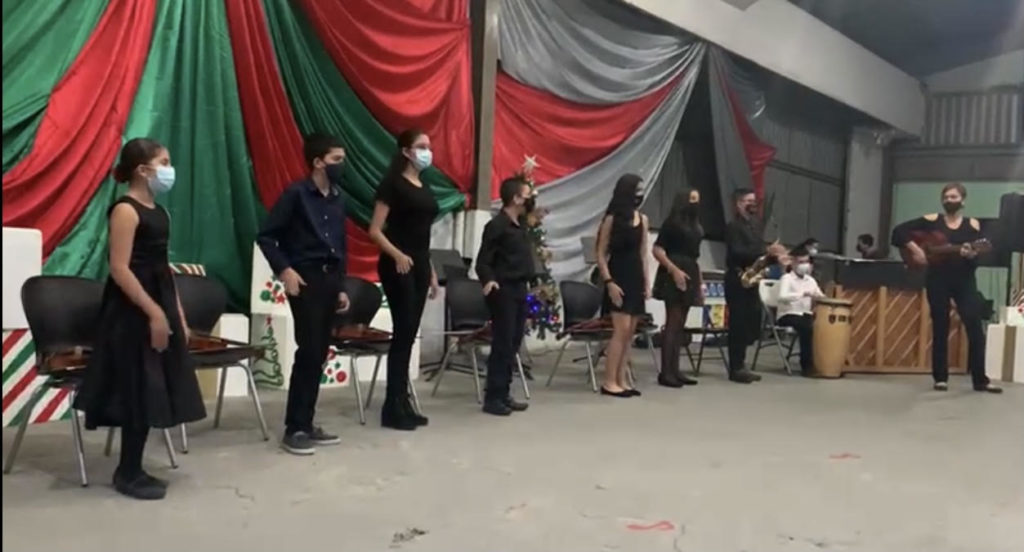
Jaques-Dalcroze Rhythmic Solfège Courses: A Personal Experience at Costa Rica’s SINEM
Introduction

Throughout my musical career, solfège (music reading and theory) has always been rather bittersweet—challenging yet fascinating. As I progressed from beginning solfège in grade school to counterpoint in college, I became frustrated with the fact that these classes were abstract, repetitive, and, ironically, not very musical. This propelled me to search for a more kinesthetic, creative, holistic, and musical way of learning solfège, which I found with Jaques-Dalcroze eurhythmics.
The present
Since the beginning of 2021, I have been teaching solfège to students ranging from 7–20 years of age at SINEM Grecia in Costa Rica with the underlying goal of ensuring that my lessons were characterized by sensitivity and musicality. This has not been easy. The COVID-19 pandemic changed our lives forever as music teachers. It has compelled us to embrace virtual lessons as the norm to stay safe instead of face-to-face lessons. I also faced some resistance with my non-traditional, movement-based outlook. Progress has been slow but steady, with many questions to field along the way. Despite the hurdles, I truly believe that applying Dalcroze pedagogy will not only mark a change for how students learn solfège but will also provide them with lifelong learning through enrichment and appreciation of the universal language called music.
What is the SINEM?
SINEM stands for the Costa Rican National Music Education System founded in 2007 by the Costa Rican Ministry of Culture and Youth. Its goal is to develop affordable orchestra and musical education programs making no distinction of race, religion, or socioeconomic status. It particularly aims to attract at-risk children and adolescents, both in cities and rural areas that are generally less likely to be exposed to formal music education or play an instrument. There are currently twenty SINEM schools throughout the country.
https://sinem.go.cr/quienes-somos
In such programs, the community of the SINEM site plays a key role in the musical development of the students, providing venues for concerts as well as ensuring regular attendance and course completion, essential not only for the musical progression of the student but for the social and cultural advancement of the community at large.
What is Jaques-Dalcroze eurhythmics?
The purpose of this article is to show how Dalcroze pedagogy may be adapted to programs, such as the aforementioned Costa Rican SINEMs. The Dalcroze approach has, at its core, Jaques-Dalcroze eurhythmics, which treats the entire body as an individual’s first instrument. Eurhythmics integrates the elements of time, space, and energy with the improvised music of the teacher to foster collective creativity where students express themselves through different means (gestures, whole body, voice) while also developing social and autonomic skills. Communication involves student exploration of space, both individually and as a group, as they hear the improvised music, generally played on the piano, thereby awakening different emotions and sensations. Eurhythmics also provides a kinesthetic education in which body movement, expression, and feeling precede music theory. The Dalcroze student experiences music through movement and thought to create ideas while learning and acquiring musical notions. According to Dalcroze himself:
The entire methodology is based on the principle that the study of theory should follow practice and that we should not teach rules to students until we have given them the opportunity to experience the facts that made those rules possible, and the first thing we should teach students is the use of all their faculties. It is only later that we can let them learn the opinions and conclusions of others.
Dalcroze, 1965, 60
Solfège
Learning a new language involves listening, repetition, discussion, writing, reinvention, and improvisation. According to Mireille Weber, former professor at the Institut Jaques-Dalcroze in Geneva, Switzerland, learning the language of music is no exception and requires the attention of the entire body.
We must grasp the musicality, the pronunciation; to be able to speak it, we must know the words, their meaning, the construction of sentences, the grammar and discover the subtleties that will allow us to express ourselves and communicate. The same thing happens with the language of music (Weber, 2019, 56).
Since solfège is a means of communication for the language of Western European music, one can establish a direct relationship with the fundamentals of eurythmics, which is addressed in the following section.
What is Dalcroze Solfège?
Dalcroze solfège is unique in its use of movement and group work to internalize musical concepts such as pitches, notes, phrases, rhythms, accents, and chords. These strategies, used simultaneously with singing, are intended to awaken our inner ear, which later evolves into reading music and scores as well as understanding and applying intonation, pitch, intervals, and harmony at an auditory, vocal, and practical level. Choral singing is also used to assimilate musical concepts such as canon and improvisation. Singing with movement, rhythmic word games, etc. allows students to “chew over” and process the many concepts of solfège, especially those involving intonation or dictation. Through singing, students are able to express what their ear understands.
Improvisation
Another pillar of Dalcrozian pedagogy is improvisation, which aside from being liberating, is an excellent communication tool that allows the teacher to adapt to the needs and feelings of their students. As Dalcrozians, we have the capacity to create music on the spot to motivate and inspire others. Dalcroze professor Madeleine Duret states that improvisation is a tool that can “do it all” since its objective is to encourage student expression whenever possible. “To invent is also to develop their [students’] imagination and express their sensitivity” (Le Rythme, 2011, 17).
Understanding the premise of improvisation is necessary to allow us to delve further into this pillar of Dalcrozian pedagogy.
a) Improvisation, language, and communication
In a eurhythmics course, improvisation is not limited to the teacher at the piano. There is vocal improvisation, movement improvisation, and improvisation with objects or instruments, both by the teacher and the students. Duret states that improvisation “is above all a musical improvisation. Whether it is musically or bodily, the reasons for improvising by students are the same: to improvise is to free oneself” (Le Rythme, 2011, p.17). The core idea is to discover how to “liberate the spirit” of the student, as Dalcroze stated, by means of our voices (sung, whispered, spoken with funny words or onomatopoeias) or sounds from percussion instruments or other objects, always bearing in mind that the body is also an instrument.
b) Improvisation and humor
A eurhythmics teacher must be able to create moments of relaxation and humor to lift the spirit of the students. Laughing facilitates acceptance of instruction and encourages positive student participation. During musical improvisation, for example, building an element of surprise into the music can result in stopping in a funny body position, which gets students smiling. This facilitates communication not only through one’s voice and body but also through musical improvisation. As a result, students discover new musical principles in a fun and poetic manner. By integrating excerpts from well-known songs or melodies, or by using certain musical styles such as the Charleston, boogie, swing, or country music, we can encourage joy and laughter during class.
c) Improvisation and group management
Dalcrozian pedagogy requires teachers to gain a better understanding of how the music they play for the class influences group dynamics through the following activities:
Working on a rhythmic motif
Teachers should have the capacity to perform variations on the music, which encourages a playful and lively class. Duret emphasizes that “…repetition of rhythmic motifs require quick rhythmic modifications without eliminating the essence of the basic rhythm: the notes in a passage, breaths, changes of register, tempo dynamics, shifting the rhythm to another voice” (Le Rythme, 2011, p.16).
Reaction exercises
These exercises consist of rhythmic, melodic, register, and tempo modifications, etc. to generate an auditory-corporal reaction. Auditory reaction exercises with “hip” or “hop” (verbal or musical) also address group management, since the students must concentrate in order to perform them. These exercises present challenges and, in addition, encourage students to execute them.
Use of contrasting exercises
One of the strengths of a Dalcroze eurhythmics lesson is the ample variety of exercises that can be performed, which increases musical and corporal vocabulary, allowing for better use of space and energy. Part of Dalcroze’s invaluable legacy invites teachers to make better use of space and energy and to diversify their classes.
You must plan every lesson rigorously according to the laws of equilibrium and contrasts. For example: 1) Rhythmic race exercises accentuated with energetic gestures to activate blood circulation. 2) Slow exercise. 3) Maximum effort exercises (memorization, polyrhythms, unequal times, silences, etc.). 4) Concentration exercises in a single position. Breathing and memory exercises. 5) Play.
Dalcroze, J. 1950, p.9
This method also embraces varied activities led by the teacher. Exercises can be done standing, sitting, in a circle, using their hands, just listening, writing, visualizing, playing, improvising freely, and others. The aim is to achieve a more enjoyable, dynamic, and playful atmosphere. (Jiménez, M. 2019)
d) Improvisation and space (time-space-energy)
Per Dalcroze, one goal of musical improvisation is to “inspire, provoke, and regulate the body and the spirit.” Music must cover space at different speeds and bodily energies. When music suggests individual exploration of space (up, down, sideways, forward, backward) or in a group setting (locations, mobility, accommodations regarding others), students not only perform self-management but also make an effort to consider the work of others in class. If we also use objects, we can better manage space, time, and energy with regards to music.
Applying Dalcroze fundamentals to SINEM courses
Although I only recently began to teach at SINEM, social distancing protocols, due to the pandemic, prevented me from teaching the full Dalcrozian rhythmic solfège pedagogy. I resorted to adapting the methodology to my lessons based on the fundamentals of Dalcroze eurhythmics. The following section describes a series of exercises that I implemented for my online SINEM courses.
- Improvisation with piano, voice, or violin to introduce the theme of the class, provoke auditory-corporal reactions, exemplify musicality, and entertain.
- Use of objects such as straws and chopsticks to work in groups to explore pulse, ensemble, specific rhythms and, above all, to play with rhythms through quick reaction exercises. Use of a giant pentagram created in an improvised manner to experiment with feet and use it to practice the different clefs (G, F, C3 and C4), musical notes, perform short dictations, and learn songs. Students can also create a “musical house” in order to work on the order of the notes, and for initial dictation activities.
- Use of the body as a first instrument. Students sit, stand, or place their hands on different parts of their body (up, down, back, sideways) based on the musical improvisation instructions and topic of the class. Desks are used as an instrument when students move their fingers over it to feel and visualize rhythms. The desk also allows the five notes of a pentascale to be represented, to address subdivided times, and visualize intervals, tones, and semitones. Hands and arms are used to gesture and reflect the different dynamics in the music as well as to express and interpret the music freely.

- Composition. The students compose various rhythmic and melodic exercises. They later film a video in which they participate as performers. The teacher can then observe and determine how well the students have internalized class content.
- Group singing in unison and in canon to encourage students to trust their own voice and to find a musical impetus different from the one they have with their instrument.

- Innovation. Starting from a simple sight-singing exercise, the melody can be transformed into a song accompanied by improvisation on the piano. This promotes greater sensitivity to musicality and builds a closer reading of musical notation in terms of nuance, change in tempo, etc.
- Singing and movement. Detecting and showing rhythms in songs through gestures and short body movements is encouraged. The signs or gestures were proposed by the students themselves in an improvisatory fashion, reflecting the rhythmic patterns of the song. Later on, the solfège or singing part was added to those movements, which led to a “sung” choreography.

- Listening to recorded music. Appreciation of choral and orchestral works as well as music from different parts of the world (Japanese, Arabic, Irish, Latin American, among others), and trying to follow a given score based on what is heard.
The activities above were adapted to comply with a proposal based on the online teaching situation. A more purist Dalcrozian methodological approach for a lesson plan is depicted in the lesson plan below.
References
- Bachmann, M. (1984). La Rythmique Jaques-Dalcroze une éducation par et pour la musique. Neuchâtel: Éditions de la Balconnière S.A.
- Cernik, P. (2017). An approach to Dalcrozian Solfège through Argentine Folk Music. [Proceedings of the Jaques-Dalcroze Institute Conference, 2015]. Haute École de Musique de Genève, collection “Musique & Recherche “11, 143.
- Duret, M. (2011) “Improvisation in Jaques-Dalcroze Pedagog”, Le Rythme, 15-17.
- Jaques-Dalcroze, É. (February 25-26, 1942) Laughter, Smile and Song. Journal of Geneva. Memories, Notes and Reviews. (L’humour, le Rire et la Chanson).
- Jaques-Dalcroze, É. (1950) Recommendations for Teachers of Rhythm. Genève: Musica Acterna II, 7-10.
- Jaques-Dalcroze, É. (1965) Rhythm, music and education. Zurich: Edition Fætisch.
- Jiménez, M. (2019) How is Benevolence Expressed in Teaching Jaques-Dalcroze Rhythmics? [Unpublished masters thesis]. Genève: Haute École de Musique de Genève.
- Norton, C. (1997) Essential Guide to Jazz Style for Keyboard. New York: Boosey & Hawkes Publishers Ltd.
- Rey-Bellet, A-C. (2014) Vingt Chansons en mouvement. Zélie-Chansons Vol. 3. Switzerland: Sympaphonie Editions.
- Sistema Nacional de Educación Musical. ¿Qué es el SINEM?. Recovered on April 2nd, 2021 de https://sinem.go.cr/quienes-somos
Weber, M. (2019). Rhythm, Solfège…A Path to Music. Atar Roto Presse S.A.
This article was originally published in the Spring 2022 issue of Dalcroze Connections, Vol. 6 No. 2.